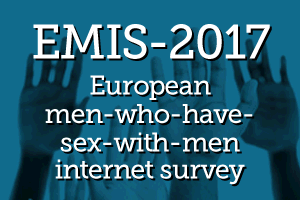Since data collection has closed in February 2018, we have distributed 39 country of residence datasets to our EMIS-2017 partners who are working on a wide range of national reports, in a variety of formats. As these reports are published they will be added here. No datasets were requested from Luxemburg, Bosnia iH, Iceland, or Turkey. As of July 2023, 22 countries have provided at least one national report. Many countries were interrupted in their report writing by the COVID-19 pandemic. We might still receive a report from the Netherlands, Poland, Portugal, and Slovakia. No reports are expected from Bulgaria, Croatia, Finland, Hungary, Lebanon, Lithuania, Latvia, North Macedonia, Romania, Serbia, Slovenia, the Philippines, or the United Kingdom.
EMIS-2017: Austria EMIS-2017 National Reports
EMIS-2017: Belarus EMIS-2017 National Reports
EMIS-2017: Belgium (België) EMIS-2017 National Reports
EMIS-2017: Belgium (Belgique) EMIS-2017 National Reports
EMIS-2017: Canada (main report) EMIS-2017 National Reports
EMIS-2017: Canada (Infographic summary) EMIS-2017 National Reports
EMIS-2017: Czechia EMIS-2017 National Reports
EMIS-2017: Cyprus EMIS-2017 National Reports
EMIS-2017: Denmark EMIS-2017 National Reports
EMIS-2017: Estonia EMIS-2017 National Reports
EMIS-2017: France EMIS-2017 National Reports
EMIS-2017: Germany EMIS-2017 National Reports
EMIS-2017: Greece (1) EMIS-2017 National Reports
EMIS-2017: Greece (2) EMIS-2017 National Reports
EMIS-2017: Ireland (Main Report) EMIS-2017 National Reports
EMIS-2017: Ireland (Community Report 1) EMIS-2017 National Reports
EMIS-2017: Ireland (Community Report 2) EMIS-2017 National Reports
EMIS-2017: Ireland (Community Report 3) EMIS-2017 National Reports
EMIS-2017: Ireland (Community Report 4) EMIS-2017 National Reports
EMIS-2017: Ireland (Infographic Demographics) EMIS-2017 National Reports
EMIS-2017: Ireland (Infographic Health) EMIS-2017 National Reports
EMIS-2017: Ireland (Infographic Behaviours) EMIS-2017 National Reports
EMIS-2017: Ireland (Infographic Needs) EMIS-2017 National Reports
EMIS-2017: Ireland (Infographic Interventions) EMIS-2017 National Reports
EMIS-2017: Ireland (Health technology assessment for PrEP) EMIS-2017 National Reports
EMIS-2017: Israel EMIS-2017 National Reports
EMIS-2017: Italy EMIS-2017 National Reports
EMIS-2017: Malta EMIS-2017 National Reports
EMIS-2017: Moldova EMIS-2017 National Reports
EMIS-2017: Norway EMIS-2017 National Reports
EMIS-2017: Russia EMIS-2017 National Reports
EMIS-2017: Spain EMIS-2017 National Reports
EMIS-2017: Sweden EMIS-2017 National Reports
EMIS-2017: Switzerland (Suisse) EMIS-2017 National Reports

